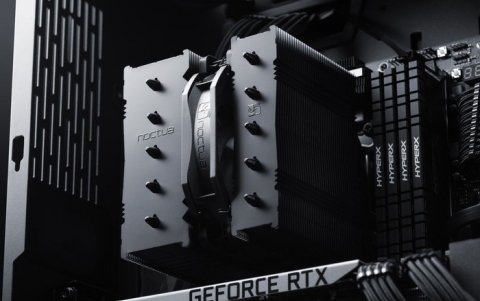
Qualcomm Announces 2.5GHz Quad-Core Snapdragon CPU for Tablets and Computing Devices
Qualcomm today announced its quad-core Snapdragon chipset designed to meet the requirements of next generation tablets and computing devices.
The new quad-core APQ8064 is the flagship chipset in the new family of Snapdragon chipsets and is based on the new micro-architecture code named "Krait." With the purpose of being built for mobile devices, this 28nm micro-architecture is achieving speeds of up to 2.5GHz per core and minimizing power consumption and heat generation.
The Snapdragon APQ8064 chip will be designed to enable the next generation of computing and entertainment devices. These devices will have significantly higher performance requirements, including support for larger screen sizes and resolutions, more complex operating systems, multi-tasking, multi-channel audio, HD gaming and stereoscopic 3D (S3D) photo and video capture and playback, as well as output in full HD to 1080P flat panel displays over HDMI.
Qualcomm created its next generation architecture and integrated four new, low-power CPU cores and its Adreno graphics into the APQ8064, enabling it to offer twelve times the available performance as well as 75 percent lower power than the first generation of Snapdragon processors.
The APQ8064 processor will include the Adreno 320 quad-core GPU, which will deliver fifteen times greater performance than the original Adreno GPU, for a console-quality gaming experience, as well as rendering rich UI?s. With up to 20 Megapixel camera support, the APQ8064 will internally synchronize two camera sensors for 3D video recording and will support external 3D video playback.
The APQ8064 will also feature support for both PCDDR3 and LPDDR2 memory, serial and PCIe interfaces and multiple USB ports.
As part of the next generation Snapdragon family, the APQ8064 will share a core set of features, including a quad-combo of connectivity solutions (i.e. WLAN, GPS, BT and FM), support for NFC and stereoscopic 3D (S3D) video and photo capture and playback. The APQ8064 also will support all available major operating systems and be software compatible across the chipset family.
Samples of the APQ8064 are anticipated to be available in early 2012.
Qualcomm also announced new single -core dual-core chipsets. The company's faimly of Snapdragon chipsets will include the single-core MSM8930 and the dual-core MSM8960. All chipsets in the family will integrate a quad-combo of connectivity solutions ? WiFi, GPS, Bluetooth and FM ? and include support for near field communication (NFC), as well as stereoscopic 3D (S3D) video and photo capture and playback.
The single-core MSM8930 is the world?s first single-chip solution with an integrated LTE modem designed to take LTE to mass market smartphones. It will include the new Adreno 305 GPU.
The dual-core MSM8960 is the world?s first dual-core solution with an integrated multi-mode 3G/LTE modem and was designed to meet the requirements of multi-tasking smartphones and tablets. It will include dual asynchronous CPU cores which can be independently controlled for maximum efficiency. The MSM8960 will also support dual-channel LP DDR memory and will feature the Adreno 225 GPU which delivers eight times the performance of the original Adreno.
Samples of the MSM8960 are anticipated to be available in Q2 2011 and samples of the MSM8930 are anticipated to be available in early 2012.
Gobi3000 Modules
Qualcomm also announced the next-generation embedded Gobi3000 certified reference design for connected mobile devices.
The new Gobi3000 module design is intended to deliver improved performance by doubling the HSPA downlink speed and enhancing the Gobi common application programming interface (API) functionality for enterprise applications. The design allows Qualcomm?s customers to offer both single-mode (UMTS) and multi-mode designs (CDMA/UMTS). Gobi3000-based modules, along with enhanced system integration and differentiated software solutions, are now available from Huawei, Novatel Wireless, Option, Sierra Wireless and ZTE.
The Gobi3000 reference design is based on Qualcomm?s MDM6200 and MDM6600 chipsets, both of which can provide support for HSPA+ data rates of up to 14.4 Mbps. The MDM6600 also supports CDMA2000 1xEV-DO Rev.
Chipset with Support for Next-generation Release 9 HSPA+
Qualcomm introduced its newest Mobile Data Modem (MDM) chipset for use in mobile broadband data devices, the MDM8225. This new MDM will support HSPA+ Release 9, the latest version of the popular mobile broadband standard, which incorporates technology enhancements that help the chipset deliver data rates of up to 84 Mbps on the downlink. The MDM8225 will be fabricated using the 28nm technology node.
The new chipsets will support HSPA+ MIMO antenna technology simultaneously with HSDPA carrier aggregation on the downlink to deliver higher data rates to users. The dual-carrier HSDPA feature will also support aggregation of carriers from different frequency bands and will give network operators greater flexibility in the use of their allocated radio spectrum to deliver doubled data rates for faster mobile broadband connectivity. Additionally, MDM8225 will support dual-carrier HSUPA operation to double uplink user data rates. The MDM8225 chipsets will support the latest Qualcomm Interference Cancellation & Equalization (Q-ICE) receiver, a feature that removes interference in a cellular network to increase network capacity and enhance the mobile broadband user experience.
The new chipsets will integrate a dedicated processor that will allow OEMs to develop new product classes and services at a lower cost.
The MDM8225 chipset will support all major 3GPP radio bands, including the 1800 MHz band. As operators plan to refarm their 1800 MHz spectrum to provide for additional data capacity, the MDM8225 will add to Qualcomm?s family chipsets that will support HSPA+ in the 1800 MHz band.
Samples of the MDM8225 are anticipated to be available in Q4 2011.
28nm Mass Market LTE/DC-HSPA+ Chipsets
Staying with Qualcomm, the company announced two new devices in its family of Mobile Data Modem (MDM) chipsets, the MDM9615 and MDM8215.
The next generation MDM9615 will support LTE (FDD and TDD), DC-HSPA+, EV-DO Rev-B and TD-SCDMA and the MDM8215 will support DC-HSPA+. These chipsets will be fabricated using the 28nm technology node and are anticipated to further drive broadband data products into the mass market on 3G and 4G networks, worldwide.
The MDM9615 and MDM8215 chipsets will be highly-optimized follow-on products to the MDM9600 and MDM8220 product family. Both chipsets will provide enhancements in modem performance, power consumption, board area and BOM expense. Both chipsets will be compatible with Qualcomm's Power Optimized Envelope Tracking (Q-POET) solution that provides further power consumption and thermal improvements allowing for smaller device form factors.
These chips will also incorporate the latest version of Qualcomm's Interference Cancellation & Equalization (Q-ICE) algorithm - leading to higher user data throughputs and increased network capacity. In addition to LTE TDD, the MSM9615 will also support TD-SCDMA, making it an optimized chipset solution well-suited for the Chinese mobile broadband market.
The MDM9615 and MDM8215 are designed to pair up with the WTR1605 radio frequency IC and PM8018 power management IC to provide an integrated chipset solution. The WTR1605 will be Qualcomm?s first Radio Transceiver in Wafer Level Package and will be a highly integrated radio transceiver with multi-mode (LTE FDD, LTE TDD, CDMA, WCDMA, TD-SCDMA, GSM) and multi-band support. The WTR1605 will be optimized for low power consumption and small footprint and will integrate a high performance GPS core with GLONASS support. Samples of the MDM9615, MDM8215, WTR1605 and PM8018 are anticipated to be available in late 2011.
The Snapdragon APQ8064 chip will be designed to enable the next generation of computing and entertainment devices. These devices will have significantly higher performance requirements, including support for larger screen sizes and resolutions, more complex operating systems, multi-tasking, multi-channel audio, HD gaming and stereoscopic 3D (S3D) photo and video capture and playback, as well as output in full HD to 1080P flat panel displays over HDMI.
Qualcomm created its next generation architecture and integrated four new, low-power CPU cores and its Adreno graphics into the APQ8064, enabling it to offer twelve times the available performance as well as 75 percent lower power than the first generation of Snapdragon processors.
The APQ8064 processor will include the Adreno 320 quad-core GPU, which will deliver fifteen times greater performance than the original Adreno GPU, for a console-quality gaming experience, as well as rendering rich UI?s. With up to 20 Megapixel camera support, the APQ8064 will internally synchronize two camera sensors for 3D video recording and will support external 3D video playback.
The APQ8064 will also feature support for both PCDDR3 and LPDDR2 memory, serial and PCIe interfaces and multiple USB ports.
As part of the next generation Snapdragon family, the APQ8064 will share a core set of features, including a quad-combo of connectivity solutions (i.e. WLAN, GPS, BT and FM), support for NFC and stereoscopic 3D (S3D) video and photo capture and playback. The APQ8064 also will support all available major operating systems and be software compatible across the chipset family.
Samples of the APQ8064 are anticipated to be available in early 2012.
Qualcomm also announced new single -core dual-core chipsets. The company's faimly of Snapdragon chipsets will include the single-core MSM8930 and the dual-core MSM8960. All chipsets in the family will integrate a quad-combo of connectivity solutions ? WiFi, GPS, Bluetooth and FM ? and include support for near field communication (NFC), as well as stereoscopic 3D (S3D) video and photo capture and playback.
The single-core MSM8930 is the world?s first single-chip solution with an integrated LTE modem designed to take LTE to mass market smartphones. It will include the new Adreno 305 GPU.
The dual-core MSM8960 is the world?s first dual-core solution with an integrated multi-mode 3G/LTE modem and was designed to meet the requirements of multi-tasking smartphones and tablets. It will include dual asynchronous CPU cores which can be independently controlled for maximum efficiency. The MSM8960 will also support dual-channel LP DDR memory and will feature the Adreno 225 GPU which delivers eight times the performance of the original Adreno.
Samples of the MSM8960 are anticipated to be available in Q2 2011 and samples of the MSM8930 are anticipated to be available in early 2012.
Gobi3000 Modules
Qualcomm also announced the next-generation embedded Gobi3000 certified reference design for connected mobile devices.
The new Gobi3000 module design is intended to deliver improved performance by doubling the HSPA downlink speed and enhancing the Gobi common application programming interface (API) functionality for enterprise applications. The design allows Qualcomm?s customers to offer both single-mode (UMTS) and multi-mode designs (CDMA/UMTS). Gobi3000-based modules, along with enhanced system integration and differentiated software solutions, are now available from Huawei, Novatel Wireless, Option, Sierra Wireless and ZTE.
The Gobi3000 reference design is based on Qualcomm?s MDM6200 and MDM6600 chipsets, both of which can provide support for HSPA+ data rates of up to 14.4 Mbps. The MDM6600 also supports CDMA2000 1xEV-DO Rev.
Chipset with Support for Next-generation Release 9 HSPA+
Qualcomm introduced its newest Mobile Data Modem (MDM) chipset for use in mobile broadband data devices, the MDM8225. This new MDM will support HSPA+ Release 9, the latest version of the popular mobile broadband standard, which incorporates technology enhancements that help the chipset deliver data rates of up to 84 Mbps on the downlink. The MDM8225 will be fabricated using the 28nm technology node.
The new chipsets will support HSPA+ MIMO antenna technology simultaneously with HSDPA carrier aggregation on the downlink to deliver higher data rates to users. The dual-carrier HSDPA feature will also support aggregation of carriers from different frequency bands and will give network operators greater flexibility in the use of their allocated radio spectrum to deliver doubled data rates for faster mobile broadband connectivity. Additionally, MDM8225 will support dual-carrier HSUPA operation to double uplink user data rates. The MDM8225 chipsets will support the latest Qualcomm Interference Cancellation & Equalization (Q-ICE) receiver, a feature that removes interference in a cellular network to increase network capacity and enhance the mobile broadband user experience.
The new chipsets will integrate a dedicated processor that will allow OEMs to develop new product classes and services at a lower cost.
The MDM8225 chipset will support all major 3GPP radio bands, including the 1800 MHz band. As operators plan to refarm their 1800 MHz spectrum to provide for additional data capacity, the MDM8225 will add to Qualcomm?s family chipsets that will support HSPA+ in the 1800 MHz band.
Samples of the MDM8225 are anticipated to be available in Q4 2011.
28nm Mass Market LTE/DC-HSPA+ Chipsets
Staying with Qualcomm, the company announced two new devices in its family of Mobile Data Modem (MDM) chipsets, the MDM9615 and MDM8215.
The next generation MDM9615 will support LTE (FDD and TDD), DC-HSPA+, EV-DO Rev-B and TD-SCDMA and the MDM8215 will support DC-HSPA+. These chipsets will be fabricated using the 28nm technology node and are anticipated to further drive broadband data products into the mass market on 3G and 4G networks, worldwide.
The MDM9615 and MDM8215 chipsets will be highly-optimized follow-on products to the MDM9600 and MDM8220 product family. Both chipsets will provide enhancements in modem performance, power consumption, board area and BOM expense. Both chipsets will be compatible with Qualcomm's Power Optimized Envelope Tracking (Q-POET) solution that provides further power consumption and thermal improvements allowing for smaller device form factors.
These chips will also incorporate the latest version of Qualcomm's Interference Cancellation & Equalization (Q-ICE) algorithm - leading to higher user data throughputs and increased network capacity. In addition to LTE TDD, the MSM9615 will also support TD-SCDMA, making it an optimized chipset solution well-suited for the Chinese mobile broadband market.
The MDM9615 and MDM8215 are designed to pair up with the WTR1605 radio frequency IC and PM8018 power management IC to provide an integrated chipset solution. The WTR1605 will be Qualcomm?s first Radio Transceiver in Wafer Level Package and will be a highly integrated radio transceiver with multi-mode (LTE FDD, LTE TDD, CDMA, WCDMA, TD-SCDMA, GSM) and multi-band support. The WTR1605 will be optimized for low power consumption and small footprint and will integrate a high performance GPS core with GLONASS support. Samples of the MDM9615, MDM8215, WTR1605 and PM8018 are anticipated to be available in late 2011.





















